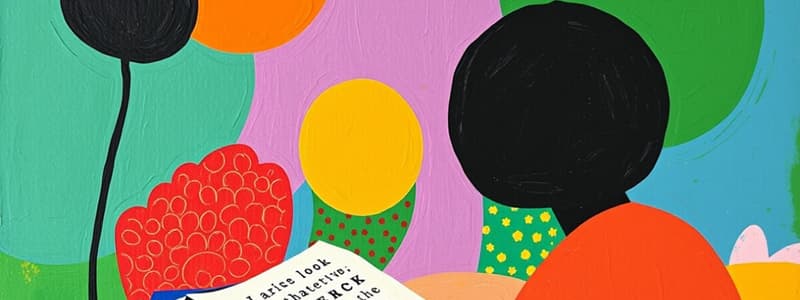Podcast
Questions and Answers
The first king of balagtasan is known as 'Huseng Batute', whose real name is ______.
The first king of balagtasan is known as 'Huseng Batute', whose real name is ______.
Jose Corazon de Jesus
The literary competition known as ______ is characterized by poetic debate.
The literary competition known as ______ is characterized by poetic debate.
Balagtasan
A kind of essay that presents information is called ______.
A kind of essay that presents information is called ______.
Sanaysay
The conclusion of a written work is referred to as ______.
The conclusion of a written work is referred to as ______.
Florante and Laura consists of ______ stanzas.
Florante and Laura consists of ______ stanzas.
The term for language used in literature is called ______.
The term for language used in literature is called ______.
The significant character who is a brave general and son of Duke Briseo is ______.
The significant character who is a brave general and son of Duke Briseo is ______.
Maria Asuncion Rivera is the one whom ______ loved the most.
Maria Asuncion Rivera is the one whom ______ loved the most.
Flashcards are hidden until you start studying
Study Notes
Filipino Poets and Literary Forms
- Patulang Pagtatalo: A traditional Filipino poetic debate format, highlighting eloquence and argumentation.
- Balagtasan: A specific type of poetic debate popularized in the Philippines, named after Francisco Balagtas.
- Bucanegan: A poetic form specific to Ilocos, reflecting local culture and language.
- Crissotan: Another form of poetic debate, named after Juan Crissostomo Soto, showcasing stylistic uniqueness.
- Jose Corazon de Jesus: Known as “Huseng Batute,” he is referred to as the “King of Balagtasan.”
- Florentino Collantes: Recognized as the second king of Balagtasan, contributing significantly to the art form.
- Pedro Bucaneg: Regarded as the father of Ilocano literature, his works are foundational in Ilocano poetry.
- Juan Crissostomo Soto: A pivotal figure known as the father of Kapampangan literature, influencing poetic expressions.
- Francisco Balagtas: Revered as the father of Balagtasan and a major figure in Philippine literature.
Types of Essays
- Informative Essays: Present factual information and insights on various topics.
- Personal Essays: Share personal experiences and lessons learned.
- Narrative Essays: Include storytelling elements to engage readers.
Essay Structure
- Introduction: Captures the reader's attention; sets the context for the essay.
- Body: Elaborates on the author's ideas and arguments, adding detail and depth.
- Conclusion: Summarizes key points and provides final thoughts or resolutions.
Levels of Language
- Colloquial Language: Everyday language used in common conversations.
- Literary Language: Language used in literature, marked by stylistic and artistic merit.
- National Language: Language officially prescribed by law.
- Provincial Language: Dialects derived from various regional languages in the Philippines.
Life of Francisco Balagtas
- Birthdate: April 2, 1788, marking the beginning of a significant literary career.
- Florante at Laura: Contains 399 stanzas, highlighting the depth of Balagtas’s work.
- Children: Francisco Balagtas had four children.
- Early Employment: Worked as a servant in Tondo, Manila, which opened avenues to literary influences.
- Romantic Interests: His first love was Magdalena Ana Ramos, with Maria Asuncion Rivera being the one he loved most deeply.
- Structure of Florante at Laura: Each stanza consists of four lines and twelve syllables, showcasing Balagtas’s technical prowess.
Characters in Florante at Laura
- Florante: Heroic general, son of Duke Briseo and Princess Floresca; symbolic of valor and loyalty.
- Duke Briseo: Father of Florante, advisor to King Linceo, embodying wisdom and nobility.
- Princess Floresca: Florante's loving mother, wife of Duke Briseo, and daughter of the King of Crotona; represents maternal love and sacrifice.
Studying That Suits You
Use AI to generate personalized quizzes and flashcards to suit your learning preferences.




